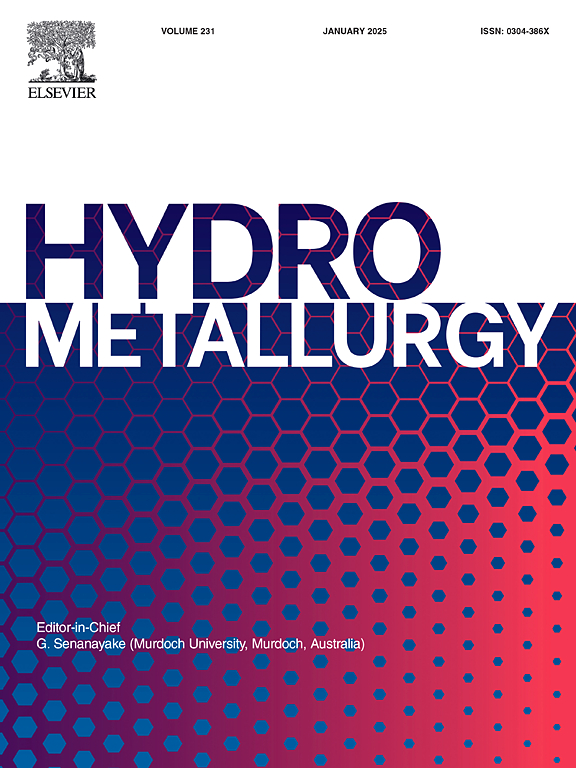矿物学特征和pH值对地浸提铀的影响——以哈达图铀矿床为例初步分析
IF 4.8
2区 材料科学
Q1 METALLURGY & METALLURGICAL ENGINEERING
引用次数: 0
摘要
砂岩型铀矿床中铀矿石的矿物学属性对铀矿地浸选择和提纯具有重要意义。然而,在不同的操作条件下,这些矿物学特征与铀浸出效率之间的关系仍然是一个未充分研究的领域。为此,本研究采集了中国哈达图铀矿床的铀矿石样品,进行了光学显微镜(OM)、扫描电镜(SEM)、x射线荧光光谱(XRF)、碳酸盐化学分析以及不同条件下的浸出实验。研究发现:(1)铀矿石中石英(60.2%)、长石(18.9%)、总铁(4.56%)丰度较高,碳酸盐(0.3%)、CaO(0.7%)、MgO(0.39%)含量较低。(2)铀矿化以沥青铀矿为主,与黄铁矿、有机质、粘土矿物密切相关。(3)在平均浸出率方面,不同药剂在不同pH下的浸出率不同:(1)H2SO4在pH <下的浸出率为74.4%;2、(ii)在pH 4-5时CO2和O2浸出41.9%,以及(iii)在pH ~ 8时NH4HCO3和H2O2浸出53.8%。值得注意的是,酸浸法的性能比其他两种方法分别高出1.78和1.38倍。铀的浸出效率主要受矿石矿物组成、铀矿物赋有方式、浸出剂和ph值的选择等因素的影响。矿物学分析和浸出实验表明,采用酸性ISL工艺对哈达图矿床的开采是非常合适的。该研究为Hadatu铀矿床的ISL开采提供了有价值的见解,并为具有相似矿物学属性的类似砂岩型铀矿床提供了新的视角。本文章由计算机程序翻译,如有差异,请以英文原文为准。
The influence of mineralogical characteristics and pH on uranium extraction via in-situ leaching: Preliminary case analysis of the Hadatu uranium deposit, China
The mineralogical attributes of uranium ore within sandstone-hosted uranium deposits hold paramount significance in the selection and refinement of in-situ leaching (ISL) of uranium. Nevertheless, the relationship between these mineralogical characteristics and uranium leaching efficiency under varying operational conditions remains an understudied area. Therefore, this study collected uranium ore samples from the Hadatu uranium deposit, China, and carried out optical microscopy (OM), scanning electron microscopy (SEM), X-ray fluorescence spectroscopy (XRF), and carbonate chemical analysis, as well as leaching experiments under different conditions.
This study found that: (1) The uranium ore from the deposit exhibits relatively high abundances of quartz (60.2 %), feldspar (18.9 %), and total iron (4.56 %), whereas the concentrations of carbonate (0.3 %), CaO (0.7 %), and MgO (0.39 %) are notably low. (2) Uranium mineralization is predominantly composed of pitchblende, which is intimately associated with pyrite, organic matter, and clay minerals. (3) In terms of average leaching efficiency, the ore displays different leaching efficiencies with different reagents at different pH: (i) 74.4 % with H2SO4 leaching at pH < 2, (ii) 41.9 % with CO2 and O2 leaching at pH 4–5, and (iii) 53.8 % with NH4HCO3 and H2O2 leaching at pH ∼ 8. Notably, the acid leaching method outperforms the other two methods by a factor of 1.78 and 1.38, respectively.
The leaching efficiency of uranium is primarily influenced by the mineralogical composition of the ore, the occurrence mode of uranium minerals, and the choice of leaching reagents and pH. Both mineralogical analyses and leaching experiments indicate that the application of an acid ISL process is highly suitable for the exploitation of the Hadatu deposit. This study offers valuable insights for ISL mining in the Hadatu uranium deposit and introduces a new perspective for similar sandstone-hosted uranium deposits with comparable mineralogical attributes.
求助全文
通过发布文献求助,成功后即可免费获取论文全文。
去求助
来源期刊

Hydrometallurgy
工程技术-冶金工程
CiteScore
9.50
自引率
6.40%
发文量
144
审稿时长
3.4 months
期刊介绍:
Hydrometallurgy aims to compile studies on novel processes, process design, chemistry, modelling, control, economics and interfaces between unit operations, and to provide a forum for discussions on case histories and operational difficulties.
Topics covered include: leaching of metal values by chemical reagents or bacterial action at ambient or elevated pressures and temperatures; separation of solids from leach liquors; removal of impurities and recovery of metal values by precipitation, ion exchange, solvent extraction, gaseous reduction, cementation, electro-winning and electro-refining; pre-treatment of ores by roasting or chemical treatments such as halogenation or reduction; recycling of reagents and treatment of effluents.
 求助内容:
求助内容: 应助结果提醒方式:
应助结果提醒方式:


